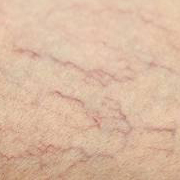Getting Rid of Spider Veins
 Spider veins, technically known as telangiectasias, are those tiny purple and red blood vessels that develop on the thighs or lower legs over the years. While there are many myths about where these veins come from—gaining weight or crossing your legs too much, for example—the truth is much simpler: for 80% of people who develop them, spider veins are hereditary.
While it may be a relief to some that this is the case, for those of us who have received this dubious inheritance from our parents it can be frustrating to know that there’s virtually nothing we can do to prevent spider veins from forming—especially since they increase in size over time.
Spider veins, technically known as telangiectasias, are those tiny purple and red blood vessels that develop on the thighs or lower legs over the years. While there are many myths about where these veins come from—gaining weight or crossing your legs too much, for example—the truth is much simpler: for 80% of people who develop them, spider veins are hereditary.
While it may be a relief to some that this is the case, for those of us who have received this dubious inheritance from our parents it can be frustrating to know that there’s virtually nothing we can do to prevent spider veins from forming—especially since they increase in size over time.
Whatever people might try to tell you, vitamin supplements will not prevent spider veins, and tanning will not hide them (excessive sun exposure can actually make them worse). There is one environmental factor that science has identified as having an effect: research has found that workers who stand regularly in their jobs are more susceptible than others, so if you have such a job, finding ways to take breaks and sit down every once in a while will certainly help. In general, though, dealing with spider veins has less to do with prevention and more to with treatment once you have them.
Sclerotherapy is considered the gold standard in treating people with spider veins because it allows us to treat multiple veins in one session. Here’s how it works: First, we thoroughly cleanse the area with alcohol. Then, using a tiny syringe fitted with a micro needle (allowing for precision, and also making the needle placement virtually painless), we inject a small amount of sclerosing solution into the veins one by one.
Sclerosing solution works by displacing the blood within the vein and then irritating the lining of the vein itself, which makes it swell and stick shut, preventing the blood from reentering the area. Ultimately, without blood flowing through it, the vein disappears on its own.
Each vein may require more than one injection—on average, three treatments are necessary for complete correction—but with proper follow-through, most will disappear for good in two weeks to two months. In most cases, about 50 to 70 percent of treated veins are eliminated after three sessions.
The best part? If you’re really set on getting rid of your spider veins, injection sclerotherapy is effective enough that you shouldn’t need to opt for the more intensive treatment option, which is an invasive surgical procedure.
Interested in learning more about sclerotherapy? Give us a call and set up a free consultation today!